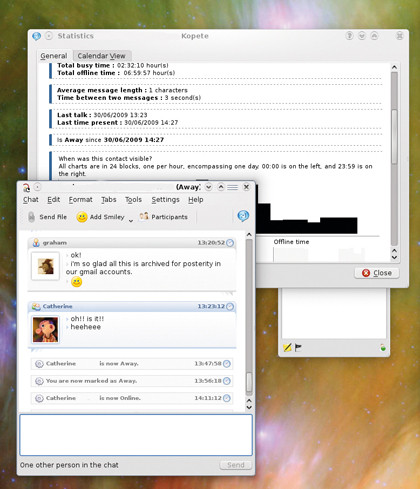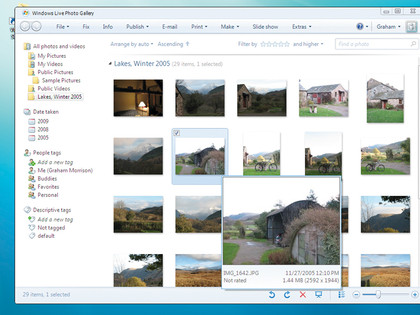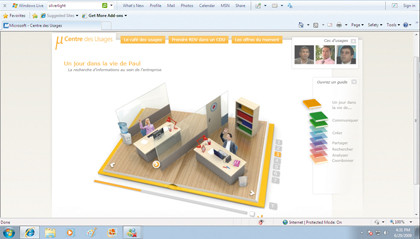Head to head: Linux vs Windows 7
How does Linux stack up against Microsoft's latest champion?
The best example of a core application associated with an operating system is the web browser. But thanks to the legal wrangling that has surrounded Microsoft's browser bundling, Internet Explorer 8 isn't going to be as fatally intertwined in the operating system as its forebears were.
The European release isn't even going to include a browser by default, which leaves users with the bizarre difficulty of not having a browser available to download an alternative. This may also be why Microsoft chooses not to create more powerful applications for these core tasks, perhaps not wanting to risk the wrath of competing vendors or the European Monopolies Commission.
And while these restrictions may seem harsh in today's online environment, it's a great opportunity for Linux to push integrated desktop applications as a serious bonus.
In Windows 7, these essential tools need to be downloaded separately under the Windows Live branding. Eight applications are selectable, and these include the latest generation of Microsoft's Messenger, Outlook Express, Word Pad, a content filter and Silverlight – Microsoft's competitor to Adobe's Flash.
In Linux terms you might liken them to Pidgin or Kopete, Evolution, Kate and Gedit, DansGuardian and Moonlight. But the difference with the Microsoft offerings is that they feel very much cut-down, as the company would rather have you pay more for the fully functional versions.
Instant messaging
Despite Windows ports of Pidgin, Windows Messenger is still the instant messaging client of choice for most people on the Windows desktop. This is probably because it offers Windows users a seamless way of communicating with other Windows users, and as long as your contacts are using the same client, video and voice chat is usually just a click or two away.
Get daily insight, inspiration and deals in your inbox
Sign up for breaking news, reviews, opinion, top tech deals, and more.

AD FREE: Kopote has the ability to integrate with a wide variety of sources, including Facebook
Over the years, there has been steady progress, but nothing revolutionary, and the same is true of the version currently shipping with the Windows 7 release candidate. It's the same version that was shipped as Windows Live Messenger 2009 at the beginning of the year, and the first thing the average Linux user will notice is the embedded advertising.
You can't open the main window or a chat window without a small banner or text fighting for your attention. If you're chatting to other Windows Live users you do get the advantage of seamless voice and video chat, but that's the only advantage that Microsoft's Messenger has over multi-protocol clients like Pidgin and Kopete.
Kopete in particular is a brilliant application that can send messages to almost anyone and anything willing to accept them. AIM, Jabber, Google Talk, Windows Live and even Facebook are all catered for through a series of plug-ins.
Photo management
Whether you choose Digikam or F-Spot, there's no doubt that Linux desktop users are well catered for when it comes to photo management. Both apps can both talk to the vast majority of digital cameras, enable you to organise your collection using tags, comments and geographical data, and then upload sections of your library to a variety of online photo repositories.

WINDOWS LIVE: Microsoft Live Photo Gallery needs you to sign into your Live account to organise your photos
Microsoft's offering, by comparison, is far more modest, and a little creepy, as you have to sign into your Windows Live account when you first launch the application. This is because your library is closely tied to your online presence. They can be published on to Windows Live with a single click, and Flickr, Facebook and SmugMug are supported through third-party plug-ins.
Google's Picasa photo hosting is a conspicuous absentee, but that's perhaps because it's associated photo management tool is a better application. But Windows Live Photo Gallery is very fast, and it's an efficient way of getting photos from your camera on to an online repository with the least number of mouse clicks and CPU cycles.
Like iPhoto, Digikam and F-Spot, it offers only bread and butter editing tools such as colour, contrast, crop and redeye reduction, but there are some weird usability errors. You can't drag tags on to photos, for instance, and photos that are part of your Pictures library aren't imported into the application unless they happen to be located under the My Pictures directory, which is confusing.
Online
Another aspect of Microsoft's new operating system that isn't quite so obvious is the default installation of Silverlight. Silverlight is a web browser plug-in, and it's Microsoft's attempt to unseat the dominance of Adobe's Flash, and it performs much the same function.

SILVERLIGHT: Microsoft are hoping that Silverlight will challenge the dominance of Adobe Flash
It helps web developers create accelerated and interactive online applications for their users that plain old HTML just isn't capable of, such as YouTube or BBC iPlayer, and represents the pinnacle of Microsoft's .NET framework, using it to both develop Silverlight and as a method for creators to add program logic within its online applications.
Windows 7 is going to be the first Windows operating system to install it by default, with version 3 currently going through a period of beta testing before its planned release in July. The interesting thing about Silverlight is that there's a Linux version being developed by the same team porting .NET to Linux, and it's called Moonlight.
Moonlight offers only a subset of the functionality currently in Silverlight, but it represents an incredible effort by the programmers. Since January 2009, it's been fully compatible with Silverlight version 1.0, and a beta version released at the beginning of May implements some features from 2.0, as well as a few from the planned 3.0 release.
There's no doubt that Moonlight is a considerable way behind the Microsoft implementation, but there's a bigger problem. For some users, Moonlight represents a big chunk of Microsoft's intellectual property sitting at the heart of the Linux desktop.
This is why the inclusion of Mono on distributions like Fedora and now Debian has proved such a contentious issue, and if Silverlight becomes as dominant on the Windows platform as Microsoft hopes, it's going to become increasingly difficult to ignore either its potential on the internet, or its potential as a patent time-bomb.